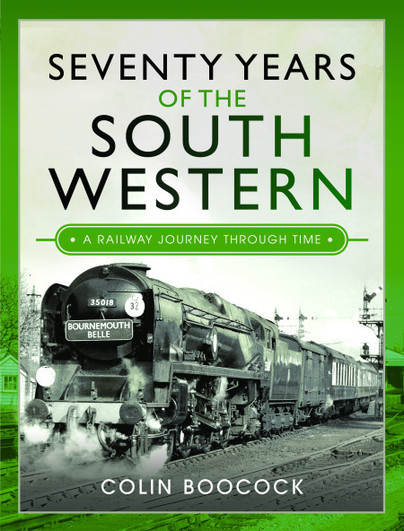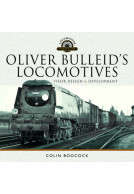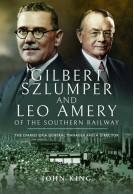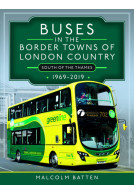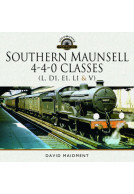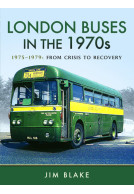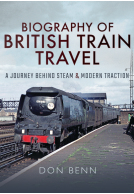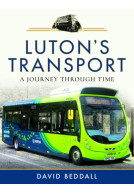Seventy Years of the South Western (Hardback)
A Railway Journey Through Time
Imprint: Pen & Sword Transport
Pages: 232
Illustrations: 250 colour & black and white illustrations & maps
ISBN: 9781526780881
Published: 27th April 2022
(click here for international delivery rates)
Need a currency converter? Check XE.com for live rates
The South Western main line is one of the most important railways in the south of England.
Colin Boocock spent a significant part of his life living on and researching the history of this centre of railway operations in the South and South West of England.
This book looks at the network over the last seventy years, from Nationalisation through to the present day. The system provides a vital link between the South and South West of Britain and London, operating a mixture of commuter services and important main line passenger trains.
Throughout the seventy years covered in this book, the South Western network also had significant flows of heavy freight between the capital and Southampton Docks and the West Country. Today there are still frequent, well-loaded container trains from Southampton to the Midlands and the North via Basingstoke and Reading.
This volume also covers the transitions from steam traction to diesel and electric in stages from the 1950s through to the late 1980s
"Well-written and lavishly illustrated it is a readable, well presented history of the Southern's operations in the South West over the last seventy years."
The Journal of the Bulleid Society - Bulleid Express, Winter 2022-23
Colin Boocock’s photographic albums published over the years have always been of immense use to me for modelling reference. His well-chosen images, many from his own lens, always seek to portray the subject in an interesting way and often reveal subtle details about the by-gone railway scene that might otherwise be missed. This new collection focusses on the former London & South Western Railway lines from Waterloo to Reading, Portsmouth, Weymouth and the 250 mile main line to the West Country as well as the much-lamented Somerset & Dorset route to Bath.
Braintree & Halstead Model Railway Club
Since this is an area I model and grew up in, this book was eagerly anticipated. It does not disappoint. Organised by regional sections of the LSWR network, the survey commences, as the title implies, in 1950 with the newly-nationalised Southern Railway adapting to a new way of working as part of British Railways and takes us right through to the much-rationalised modern privatised railway. Colin has produced some very clear maps to show the principle routes and stations, along with both open and closed lines, that formed the nexus of the South Western, and these help to identify where each picture was taken.
There are some very interesting and novel images that I had not seen before, including one on the former SDJR route at Broadstone of a Gresley articulated twin set heading north in a Bournemouth West to Templecombe working on 10th September 1960. I suspect it to be the same arctic set that worked through from Bradford Exchange to Bournemouth on 20th August 1960 captured by Roy Panting and shown in The Last Days of Steam in Dorset & Bournemouth – a most unusual visitor to Southern metals and one I intend to portray on my model!
Elsewhere there are excellent colour images from the later steam and early diesel era at Bath Junction, Gunnislake, and Pokesdown to name but a few that illustrate the breadth of traffic and motive power that made the South Western such an interesting domain. Colin’s text is thoughtful and well researched and I like the layout of the book, in geographical order, which makes areas of particular interest easy to find.
This is a very thorough and enjoyable review of the South Western section and highly recommended for modellers interested in this area.
Well known railway photographer and engineer Colin Boocock’s association with the South Western lines from London’s Waterloo station extends over most of his life, and he is in a unique position to celebrate and review the way the railway has developed since the early days of nationalisation.
West Somerset Railway Association
The book is not so much a detailed history of the period as a personal odyssey and commentary in which the book is divided into 24 chapters, mostly area-based, with thoughts on the current scene and a look into the future. Each chapter is accompanied by monochrome and colour views showing both historic and more recent scenes, complemented by well-drawn maps to illustrate the locations covered. Many of the photos used are from the author’s own cameras, and as one would expect, the quality of the images is usually first rate, and their reproduction on good quality glossy paper leaves nothing to be desired.
The chapters on individual areas include some fascinating operational detail. We learn about the complicated manoeuvres involving the stock of the Atlantic Coast Express and Devon Belle at Exeter Central. Much later on in the early years of the Bournemouth electrification, we are reminded of how a feature of the peak hour timetable was a 4VEP EMU and a 4TC trailer unit being driven from Basingstoke to Waterloo by a Class 33 at the rear, although whether the loco was actually doing much propelling or being dragged is perhaps a moot point. This arrangement was made possible by the Southern Region’s ingenious control system which allowed diesel electric and electro-diesel locos to work in multiple with standard EMUs.
There is certainly plenty of variety to be found in the locations depicted, which vary from the multi-track complications of Clapham Junction to the weed-strewn remains at Merstone on the Isle of Wight. Other memorable images include three T9s at Southampton Terminus, a modern class 444 EMU under the refurbished overall roof of Bournemouth, a rare view of a WR Prairie tank at Southampton Central, and a superbly composed shot of a Class 442 EMU at Waterloo alongside curvaceous roofs and the London Eye.
In a final chapter, the author speculates on future developments such as the possible cascading of 125 mph stock for use on Waterloo – Exeter services, the likelihood of bi-modal trains being used on the third rail and non-electrified sections, and the possibility of further DC electrification on an infill basis. Much, he concludes, will depend on decisions taken by the Treasury in the wake of the disruption to the economy caused by the Covid 19 pandemic.
The author has produced a very readable and well presented book which provides a useful overview of a period of substantial change, and which gives train lovers many fine views of the various motive power used on the South Western lines over the last 70 years.
Review as featured in
Woking News and Mail
As featured in the article: 'New history of main rail line'
Hampshire Independent
In his new book Seventy Years of the South
Hampshire Independent, July 2022
Western, recently published by Pen & Sword Books, author Colin Boocock – a retired railway officer with a forty year career - describes the history of the South Western main line.
This new history looks at the network over the last seventy years, from nationalisation through to the present day.
The system provides a vital link between the South and South West of Britain and London, operating a mixture of commuter services and main line passenger trains.
Throughout the years covered in this book, the South Western network also had significant
flows of heavy freight between the capital and
Southampton Docks and the West Country.
The 232-page book includes 250 colour and black and white photographs and maps. It is available now from www.pen-and-sword.co.uk.
You never have to doubt the quality of any book
Steam World, July 2022
with the name Colin Boocock on the cover, and
this one won’t disappoint either. It’s his personal story of his beloved ‘South
Western’, gained from a lifetime of close association as an enthusiast, being an apprentice at Eastleigh Works in the days of steam, and a
master photographer. Today’s third rail electric units ply the same tracks from Waterloo
to Bournemouth that was once the preserve of steam locomotives designed by Beattie, Adams, Drummond, Urie, Maunsell and Bulleid. The author has witnessed them all. Colin’s interest began as a young member of Bournemouth Railway Club, and after 15 years at Eastleigh from 1954. Many chapters begin well with a good quality map, and we are guided along the main traffic corridors, suburban hubs, and visit the Somerset & Dorset and
defunct branch lines before discussing modern trains and franchises. The black and white images of steam sweep you away, such as three Ivatt 2-6-2Ts busying themselves inefficiently at Tipton St
Johns in April 1963 when trains were divided to go to Budleigh Salterton and Exmouth. We also visit Ventnor on the Isle of Wight in June 1956, where the fireman is busying himself clearing ash from the opened smokebox of ‘O2’ 0-4-4T No. 18 Ningwood, and see ‘Merchant Navy’ 4-6-2s on the ‘Bournemouth Belle’. Over the years, the author has always predicted the future with
some accuracy, but of the next twenty he says:” I doubt if I shall be around to see what really happens, but if I do reach 104, then maybe!” Let’s hope he does.
A must have book for all Southern Railway enthusiasts and particularly those interested in the “South Western”. Colin Boocock has all the experience to look at the fortunes of his “favourite railway” over the past seventy years having trained with the Southern Region at Eastleigh in the late 1950’s and then going on to work in a senior position with alll the other BR Regions.
Peter A. Harding - Branch Line & Light Railway Publications.
Packed with much information and photographs, this fine book comes highly recommended.
About Colin Boocock
COLIN BOOCOCK is a retired railway officer whose career, mainly in mechanical and electrical engineering, spanned forty-one years full-time work on British Railways and Railtrack and a further twelve or so years in part-time consultancy.
His career started at Eastleigh Works on the Southern Region, where he was trained in the late 1950s, later going on to work at railway establishments in all of BR’s original Regions including spells in Scotland and Wales, mainly managing the maintenance of locomotives and rolling stock at a senior level.
As a life-long railway enthusiast, he travelled widely on Britain’s railways but always had a keen interest in the developments on what he still regards as his ‘home railway’, the South Western.
This volume describes in some detail the railway he grew up on: the South Western, its main lines, key railway centres and the fascinating myriad of secondary routes and branch lines.







